You can either enjoy your hiking experience or not. And if you are like us, you should ensure that your hiking experience is a good and comfortable experience for you.
One of the things that can make hiking comfortable for you is what you wear, and that includes your desired pair of socks. How? Your socks act as added protection for your feet when you’re hiking.
Once you start feeling discomfort in your feet, you can be sure that your hiking is about to become painful and uncomfortable. This is why picking (or selecting) the right pair of socks for hiking is essential.
Frequent hikers by now would know that hiking socks are different from regular socks. If your first-time hiking sucked, it’s probably because you wore the wrong pair of socks.
However, whether it’s your first time or not, you don’t have to worry. We have compiled some tips to help select the right pair of socks for your next hiking experience. Let’s find out what kind of socks you should wear for hiking.
Contents
- Do you Wear Socks with Hiking Boots?
- Do you wear socks with waterproof hiking boots?
- What socks should I wear with hiking boots?
- Do I Need Special Socks For Hiking Boots?
- What Kind of Socks To Wear Hiking In The Summer?
- Do you have to wear thick socks with hiking boots?
- Should Hiking Socks Be Thick or Thin?
- Are Cotton Socks Okay For Hiking?
- Conclusion
Do you Wear Socks with Hiking Boots?
You have probably pondered this question in your mind, and you wonder why you need to wear hiking socks at all. We understand that sometimes socks can become smelly and make your feet uncomfortable at times. However, why should you bother wearing them for hiking?
Wearing socks with boots can either make your hiking experience a lovely one or not. Yes, people wear socks with their hiking boots, and so should you. Why? Your hiking socks are almost as important as the boots.
Wearing the wrong pair of socks alone can ruin your hiking experience, let alone not wearing any at all. Hiking socks will make the experience good for you in different ways. For instance, some of the benefits of wearing hiking socks include:
1. Help cushion the feet
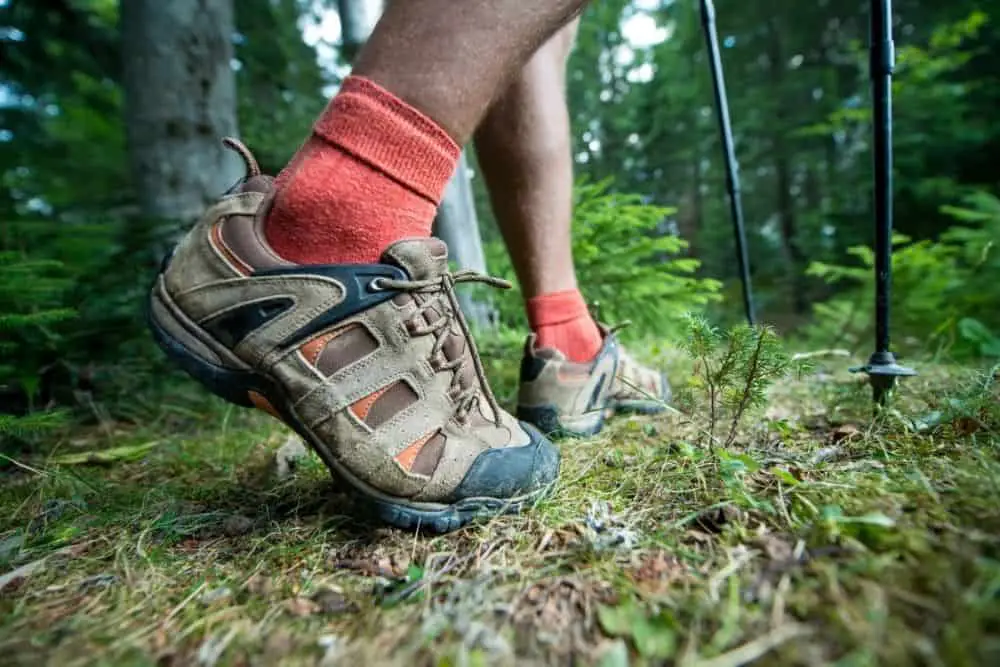
Hiking socks make your feet comfortable when you are out hiking. They are different from regular socks that you wear to school, work, or casual clothes. These socks come with extra padding to the front and back of your heels.
This helps to make the socks extra convenient. More than that, they are durable and won’t be a mess after one hiking trip. The extra padding is to ensure that your feet don’t hurt after a beautiful hiking experience.
You might not need to worry about your feet throbbing, and you can walk extra miles on rocky hills and not be in pain afterward.
2. Protect your feet from blisters
While you walk, the back of your feet constantly rubs with your hiking boots. Now, if you were putting on regular socks, the back of your heels would suffer from pain and blisters. Not only would they hurt, but they would bleed as well.
Regular socks don’t protect your feet enough from that happening. However, hiking socks designs offer protection for your feet, making the experience convenient for you.
3. They are cozy and comfortable
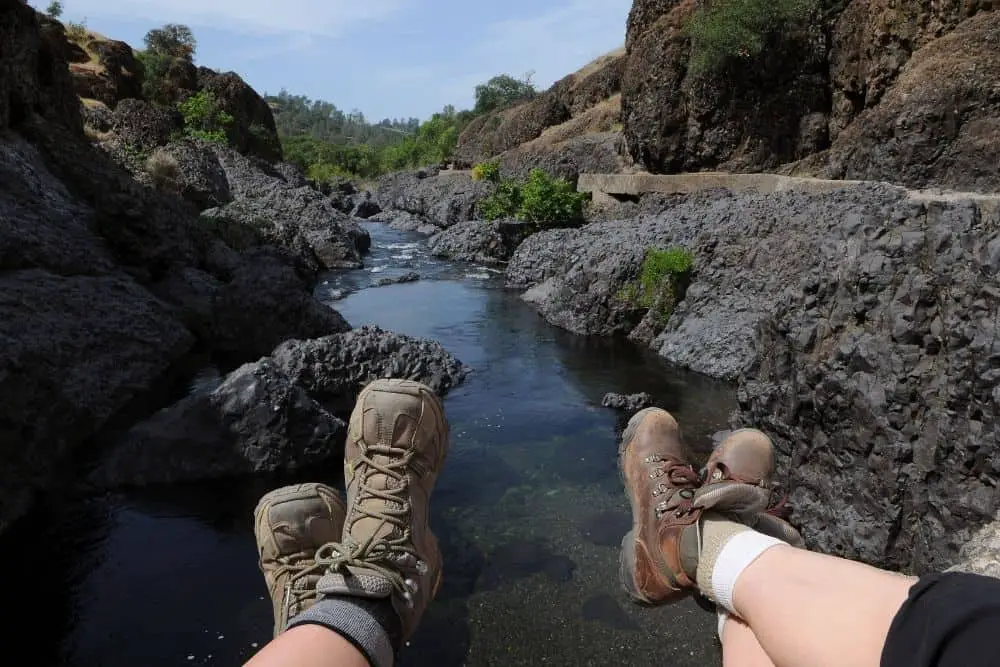
The way hiking socks are, you can find yourself wearing them all day, even when you are not hiking. They keep your feet warm, and they don’t make you feel uncomfortable at all.
Some people end up wearing their hiking socks around the house, to bed, to work, or anywhere at all. This is because they keep your feet at the right temperature. Nevertheless, they help to ensure high comfortability on all terrains while you hike.
4. Keep feet dry
Generally, people don’t wear regular socks because it makes their feet moist. In fact, regular socks are less likely to absorb moisture from your feet, making your feet smell and messy.
However, hiking socks have moisture-wicking properties that absorb sweat off your feet. In return, this helps to protect your feet against blisters. In addition, hiking socks keep your feet dry throughout your hiking adventure.
5. Keep your feet warm
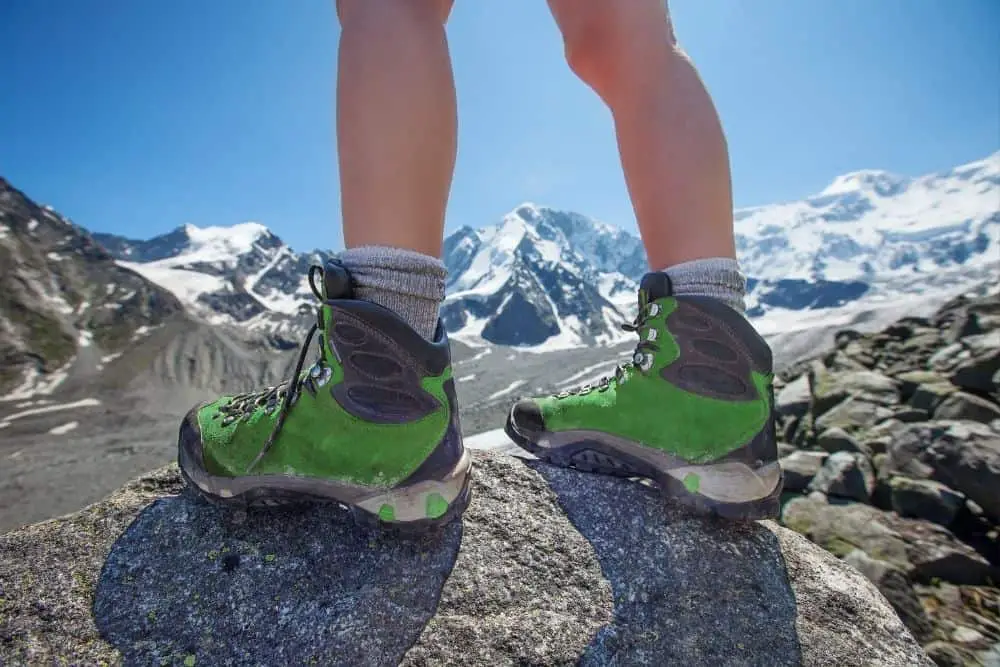
Hiking socks are warm, whether they are lightweight or heavyweight. Their designs allow them to keep your feet warm during cold weather. Additionally, the socks prevent external heat in the material from entering your feet.
Also, they prevent low temperatures from reaching your feet. They also collect sweat from your feet into the material, so your feet can be warm and dry all day long without making you feel uncomfortable when hiking.
That is to say, hiking socks make you feel comfortable, irrespective of the weather. So if you have been bothered about how cold or moist your feet will feel, you don’t have to worry.
Do you wear socks with waterproof hiking boots?
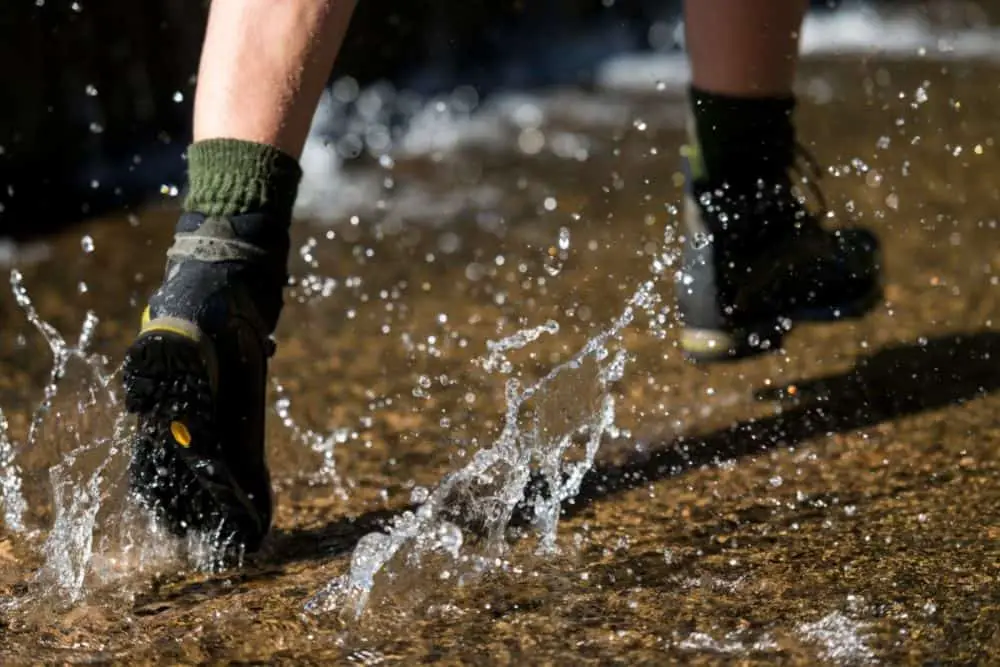
There are times you walk through muddy terrains or enter the water when you are hiking. This is why some people wear waterproof hiking boots to protect their feet from getting messy and irritating.
Read more: Can You Use Hiking Boots for Wading?
This makes you wonder whether you need to wear socks with waterproof hiking boots at all when they can protect your feet from getting wet. Socks keep your feet warm, while waterproof boots protect your legs and socks from getting wet.
The answer to whether you need to wear socks with waterproof hiking boots depends on you. You could decide whether your feet need the extra layer of protection or you are good to go with either wearing waterproof boots alone or with socks.
If you are hiking through muddy or wet areas, you may want to wear socks with your waterproof shoes.
Another thing you might want to put into consideration is the weather. For instance, if the weather is freezing or if you’re hiking in the rain, you may want to consider wearing socks with your waterproof shoes, as an added protection.
Generally, socks keep your feet warm and dry, while waterproof boots prevent your socks and feet from getting wet. Your waterproof boots may not be able to keep your feet warm throughout your hike alone.
Hiking socks would protect your feet from cold, blisters, irritation, etc. Therefore, we would advise that you wear hiking socks even when your boots are waterproof.
You should ensure that the socks you wear are for hiking because they have unique designs. As a result, they don’t expose your feet to cold, and they keep your feet warm.
What socks should I wear with hiking boots?
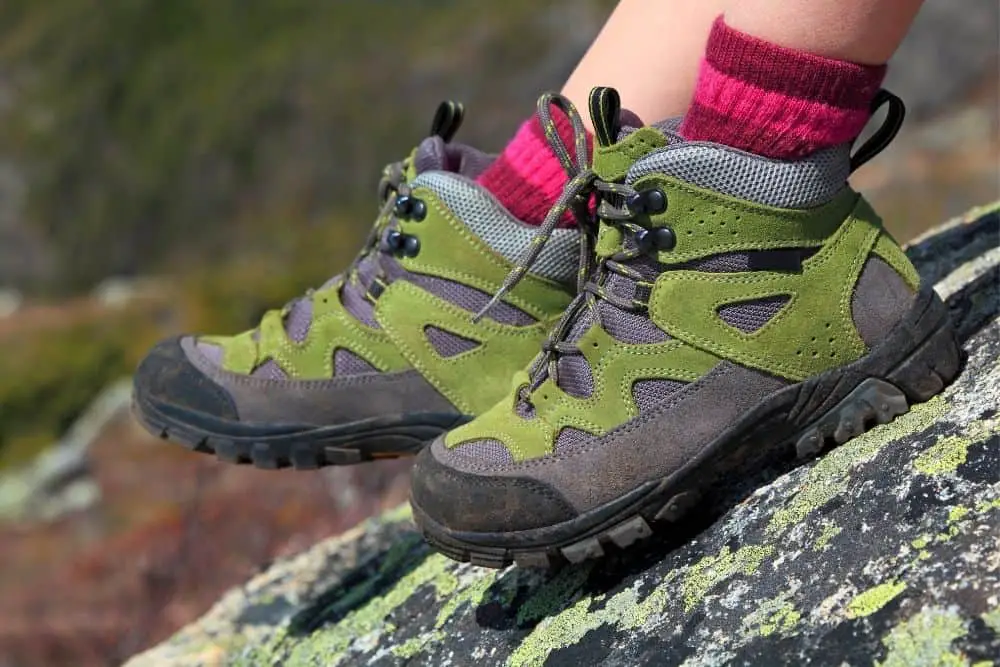
Now that you know that you need to wear socks with your hiking boots, you should ask what kind of socks you should wear. Socks come from different materials, and some are light, thick, short or long.
The choice of material for your socks will determine how comfortable, durable, warm, and fast-drying they will be. For example, some socks’ material may keep your feet warm, but they may smell after collecting some sweat.
First, we will discuss the different kinds of socks material. Then, we will examine how comfortable and durable they are for all your hiking expenditures.
Generally, your hiking socks can come from any of these fabric types:
1. Wool
Wool is a popular fabric type and is a prevalent material for hiking socks. However, we recommend that you get hiking socks made from cotton because it is suitable for any temperature.
For instance, wool prevents your feet from getting sweaty. In addition, the texture is soft, so it provides cushioning for your feet, making them feel comfortable in your hiking boots.
Also, wool socks are also antimicrobial, meaning that it doesn’t smell as much as other fabric types. Another big plus is that some wool types are usually itch-free. So, you don’t have to bend over multiple times to scratch your itching feet when you can cover longer distances.
In addition, wool socks are breathable. That is, wool socks are moisture-wicking. They wick sweat from your feet, evaporate the liquid and prevent your feet from getting wet.
Some wool manufacturers combine wool with other synthetic materials to be more durable and so that they can dry faster. In addition, wool socks will make your feet feel comfortable in your hiking boots.

Pros
- Great insulators
All clothing materials have insulators, but their level differs from other. Some materials can keep you warm for as long as possible, while others can only withstand the cold for a short period.
Wool insulation degree has a great weight to warmth ratio, making it better than other clothing materials. In addition, it creates insulating air pockets, which keep your body warm, unlike other fabric types.
Wool is better than other materials in that even when it is wet, it still provides the warm comfort that you need.
- Regulates temperature
Wool is capable of regulating temperature. How? For instance, merino wool blends easily with your body temperature, whether warm or cold. So it’s capable of making your feet cool during hot or freezing weather conditions.
How’s this possible? This is because the sheep from which merino wool originates get reared in areas with temperatures that vary from -15°C to 35°C (5°F to 95°F).
This allows the merino wool obtained from sheep to be able to adapt to different environments and weather conditions.
- Soft and comfortable
As opposed to earlier beliefs, wool socks are soft and comfortable. Back in the days, during the early part of the 20th century, people used to complain about wool being itchy and causing irritation.
This led to the rise in other alternatives like synthetic materials. However, things have changed now, especially with the evolution of technology; modern wools are now comfortable, soft, and itch-free.
For instance, there are refined modern wools like Merino. These wools are soft on the skin, making you feel comfortable all the time you wear them.
- Moist absorbent
Wool is excellent at collecting sweat from your feet. That way, the socks don’t get soaked, and your feet don’t get wet and itchy.
Additionally, wool collects sweat from your skin as vapor. Other materials aren’t like that, in that they depend on your body heat to keep the socks warm and dry after they have gathered sweat.
- Odor resistant
One unfortunate thing about wearing socks is how awful they smell after you wear them. Merino wool, for instance, contains amino acids and other natural compounds that prevent molds and bacteria from surviving on the material.
This makes it smell less than other socks. However, you should note that merino wool doesn’t kill bacteria, but it absorbs and traps them in the socks.
You can wear them for lengthy periods as you want without worrying much about the smell. Wool socks are best for hiking expenditures that exceed a day. However, this isn’t an excuse for you to be unhygienic, so wash your socks or replace your socks when you can.
- Durable
Wool socks are durable. You can use and reuse them for a longer time than other fabric types. Compared to cotton socks which are only bendable about 3,000 times, wool socks are bendable for about 20,000 times.
There are fewer chances for you to end up with holey socks when hiking wearing wool socks.
Cons
Wools socks may be the best wool socks to wear, but there are some unlikeable sides. For instance;
- They can sometimes be discomforting to wear for an extended period.
- You have to hand wash them if you want them to last long. Unfortunately, many manufacturers advise against machine washing, so you have to hand wash every time you wear them and lay them out to dry. This could get tiring and discouraging for you.
- You may buy low-grade non-merino wool socks. If you by chance buy the “unoriginal” one, get ready for some itchiness when you wear the socks. If your wool socks itch you a lot, they’re probably not original.
2. Polyester
Polyester is another fabric type used in producing socks. It is a synthetic material that absorbs moisture, insulates, and is fast drying. Some manufacturers combine it with other fabric types, like wool or nylon, for them to last longer, provide warmth, and dry fast.
![100% Waterproof Camping Socks, [SGS Certified] RANDY SUN Men's Women's Hiking Sock Snow Skiing Snowboard Fun Color Athletic Socks Large 100% Waterproof Camping Socks, [SGS Certified] RANDY SUN Men's Women's Hiking Sock Snow Skiing Snowboard Fun Color Athletic Socks Large](https://m.media-amazon.com/images/I/51gwwhkLn2L._SL500_.jpg)
Pros
- Durable
Polyester is a firm fabric type and is stronger and durable than wool or cotton. They not only stay strong, but they also don’t slack or expand, so they maintain their shapes for a long time.
- Fast drying
Polyester dries faster than other fabric types. It has a reasonable absorbency rate in that it dries quickly and keeps your feet warm in your hiking boot.
- Non-fading
Your polyester socks can maintain their color for as long as possible. This is because the color doesn’t wash or fade off like other materials.
- Soft
Polyester socks are soft, and they keep your feet warm in your boots. In addition, they are usually lightweight, so they are gentle on the skin.
- Less expensive than wool
Cons
- It isn’t environmentally friendly. If you are one for a healthy environment, you may not want to wear polyester socks because it isn’t easily compostable. Also, it isn’t so great for the environment because it doesn’t break down easily on the ground.
- It makes your feet sweat more. The polyester material isn’t that breathable. Even though they keep your feet warm while you hike, they can make your feet sweat tremendously, and they don’t allow your skin to breathe as much as it should.
- You may not be wearing them for long. This is because it is difficult to get stains out of polyester material.
3. Nylon
Nylon is a synthetic fabric material. Some manufacturers use it as the primary material when making socks. It is durable and is fast drying.

Pros
- Durable
Nylon materials are durable and cheaper than silk, and more resilient than cotton and wool. You can wear nylon socks for an extended period without worrying about them getting worn out.
- Less expensive
Nylon comes from synthetic materials, so they are less expensive than natural materials obtained from animals. Some manufacturers weave nylon in such a way that it feels like Merino wool or cashmere.
This doesn’t make it the same, but you can get the same feel at a less cheap rate.
- Moisture resistant
Nylon’s texture doesn’t allow it to collect moisture. Instead, it leaves the moisture on the material surface so that it can evaporate from the warmth your feet emit.
Nylon socks are suitable for hiking because fungi or mold can hardly build up in them when wet. And this is because they can quickly evaporate.
- Soft but solid
Nylon materials act as an alternative to silk, so they are soft and comfortable. Nylon socks make your feet warm while you’re hiking in cold weather. In addition, nylon socks remain soft for an extended period.
- Easy to wash
You can easily wash nylon socks because they are stain-resistant. However, if you are particularly careful about keeping your socks clean, you may want to get nylon hiking socks.
Cons
- Even though they are less expensive than natural materials, they are quite expensive than other synthetic materials.
- They aren’t eco-friendly. They are produced with chemicals and can pollute natural ecosystems.
- They are prone to melting and burns.
4. Silk
Silk material is a natural insulator and is moisture-wicking. In addition, silk socks are usually lightweight and soft, making your feet comfortable all through your hiking experience.
Silk is sometimes usually used as a liner in socks to make them super comfy. Silk is an excellent hiking socks choice; however, they are not as durable as other fabric types.

Pros
- Silk socks can absorb moisture keeping your feet warm and cozy all through your hiking adventure.
- They are fast-drying and dry easily after absorbing sweat from your feet. This equals less irritation and itchiness while hiking.
- Silk socks are soft and smooth on the skin, so they make you feel comfortable in your hiking boots.
Cons
- They can be challenging to clean. If your socks get muddy or dirty from wearing them around, you may be saying bye to them after wearing them for a while because the stains hardly wash off.
- The colors wash off quickly. You may not enjoy your colorful hiking socks for long if they are silk-made. Silk materials discolor easily.
- Silk socks are delicate, so they can easily tear and may cause a huge hole while you’re wearing them for hiking.
- It requires frequent dry cleaning because they get dirty quickly.
- They raise ecological concerns.
5. Spandex
Spandex hiking socks don’t usually have spandex designs alone. Instead, manufacturers combine it with other fabric types to make the socks elastic and maintain their shape.
Many hiking socks made of spandex only contain a small percentage of it, so they can maintain their texture and only wrinkle a little bit.

Pro
- Spandex socks are suitable for hiking because they are elastic. You can stretch your spandex hiking socks, and they’ll return to their shape.
Cons
- They are not breathable like other fabric types like silk, cotton, and wool. That is, they hardly absorb moisture from your feet.
- It is a synthetic material and is not eco-friendly.
- If you happen to get fake spandex socks, you may not be wearing them for long because their elasticity will wear off.
Overall, the answer to what socks you should wear for hiking depends on your preference. You also need to consider your comfort, the material’s moisture wicking ability and durability.
Do I Need Special Socks For Hiking Boots?
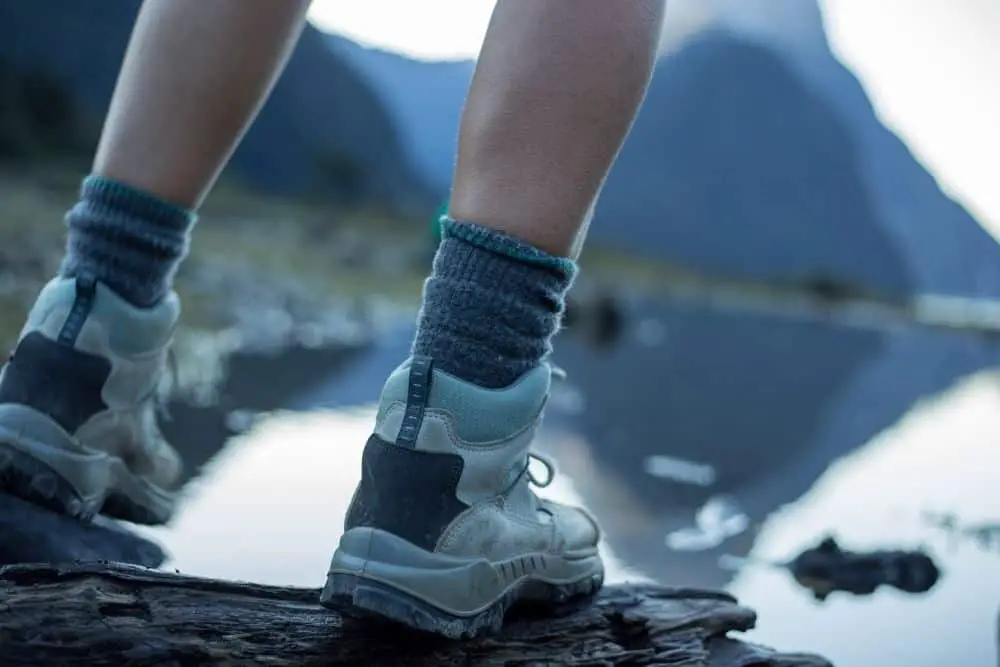
Your feet are one of the essential things on any hiking trip. This is why you need to protect them as much as you can from discomfort, pain, blisters, moisture, and irritation.
This is why you especially need socks different from your regular or usual socks.
So, the answer is yes; you do need special socks for your hiking boots. Hiking socks come with extra padding with thoughts to protect your feet from any kind of harm.
Furthermore, hiking socks also keep your feet warm and cozy throughout your trip. You can also wear them for multiple hiking trips because, unlike regular socks, these tend to wear out slowly.
What Kind of Socks To Wear Hiking In The Summer?

When choosing hiking socks, you need to consider the weather. For instance, during cold weather conditions, you have to pick warm socks with thick padding because comfort and warmth are non-negotiable.
Summer is already hot, so you don’t want to wear hiking socks that’ll make you feel very uncomfortable, sweaty, wet, irritated, and itchy. So, when selecting the kind of socks you want to wear for summer hiking, you need to consider many factors.
1. Picking wool socks over others
Generally, you will be right to choose wool socks for your hiking trips in the summer. So, how are you supposed to feel comfortable?
Wool can collect moisture from your feet without making you feel irritated. They also keep odor to the barest minimum. In case you need more conviction, check out the earlier stated pros of wool socks.
- Superior Material:Merino wool and acrylic blend,Use spandex and polyester knitting to deliver a snug...
- Soft & Comfy:The latest design ventilation function improve effective air circular properties and...
- Durability:Nylon blend knitting provide added durability in high stress areas,it avoids holes...
Last update on 2023-11-11 / Affiliate links / Images from Amazon Product Advertising API
2. Stay away from cotton socks
Cotton socks are soft and cool, but they absorb moisture easily, and they are not fast drying. So it doesn’t wick sweat but rather absorbs it.
So instead of going for 100% cotton socks, you can opt for hiking socks that are partially cotton.
3. Wear lightweight socks
Since the weather is already warm, you shouldn’t wear heavyweight socks. Lightweight socks will make your feet cool while at the same time reducing sweat from your feet.
Wearing lightweight socks doesn’t mean that they won’t have extra padding or prevent your feet from blisters. However, they will still protect your feet just fine.
- Material Features: This hiking socks are made of 80% cotton, 20% polyester. Soft and comfortable,...
- Size and washing: Two sizes fit all people,Medium Size(US 6-9),Large Size(US 9~12). It can be washed...
- Product advantages: The Arch support on instep prevents displacement, terry design on sock bottom...
Last update on 2023-11-11 / Affiliate links / Images from Amazon Product Advertising API
4. Socks length
People wear different lengths of socks when hiking, which also depends on the height of the boot. Therefore, you want to ensure your socks protect your feet enough from blisters.
If your hiking boot is a low-top shoe, you can wear hiking socks that stop slightly above the cuff. Wear crew length if your hiking boot shaft is high.
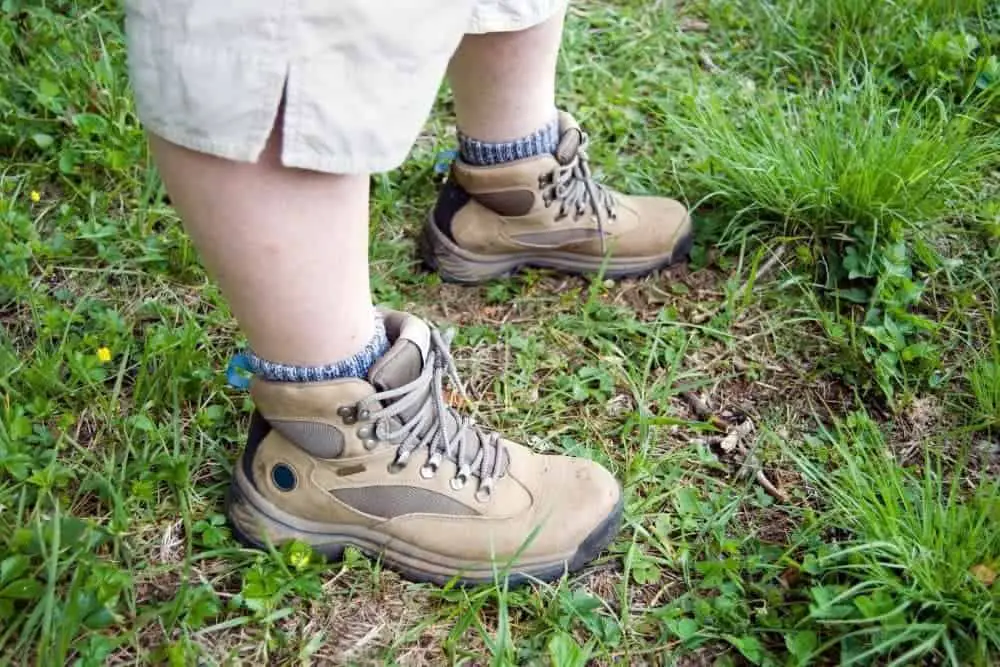
Do you have to wear thick socks with hiking boots?
You should wear thick socks when you are going hiking. Usually, hiking socks are thicker than regular socks, and so that they can protect your feet.
Hiking socks’ thickness differs depending on the material and whether they are lightweight, midweight, or heavyweight.
If you want to choose based on how thick they are, you have to consider your hiking trails, hiking boots, comfortability, and the weather.
Should Hiking Socks Be Thick or Thin?
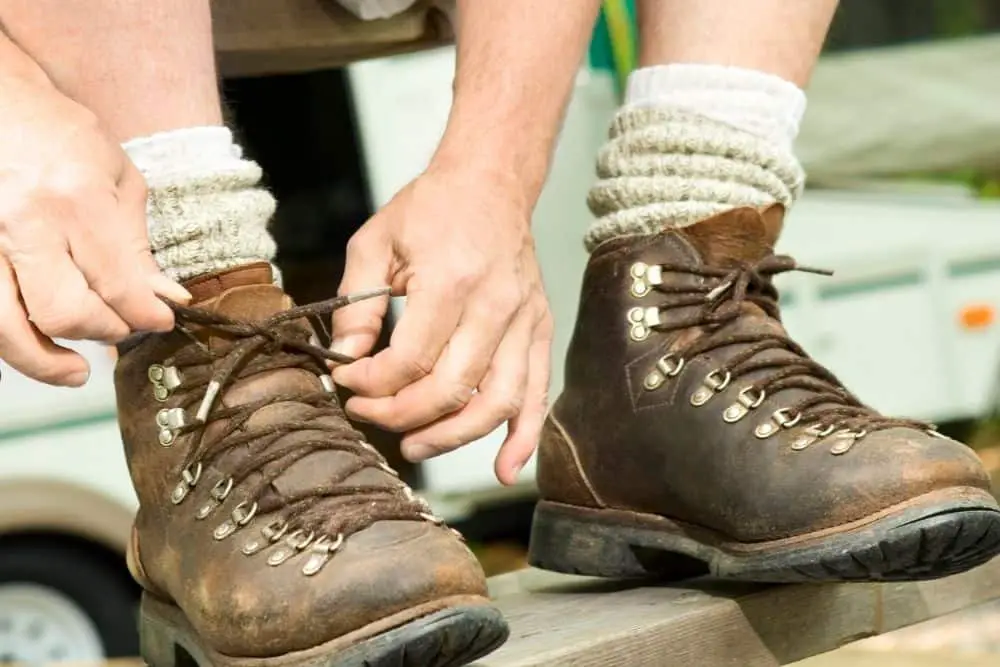
Hiking socks are available in different thicknesses. Some are light, mid, or heavy. Whether you wear light, mid, or heavyweight hiking socks depends on the weather and the intensity of the hiking trip.
Light hiking socks are suitable for warm days, short hiking trips, and easy trails. Your feet can feel cool throughout the journey. You also don’t have to worry about feeling uncomfortable or the socks wearing out because you are already back before that happens.
Mid-thick socks are suitable for warm days, longer trips, and more strenuous trails. They don’t make your feet too cold or warm or uncomfortable throughout the journey.
Super thick socks are for colder weather, more challenging hiking trails, and longer journeys. The thick padding will keep your feet warm and comfortable in your boots till you are back. They also keep your feet dry and wick moisture from your feet.
There are also thin socks with no cushioning at all that are good for scorching hot weather conditions. They have very thin padding and are very breathable.
Are Cotton Socks Okay For Hiking?
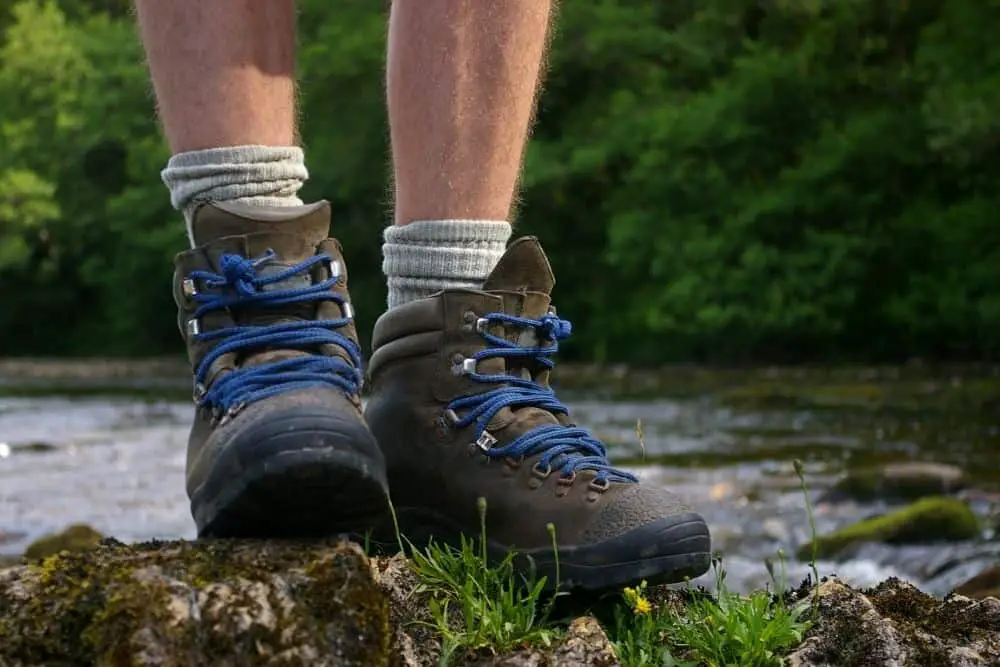
Cotton socks are soft and comfortable, but they can be the wrong hiking socks choice. They can make your feet feel uncomfortable throughout your hiking trip.
How?
- Cotton is heavy and can get heavier when it gets wet. For example, your feet tend to sweat when hiking, and cotton socks get wet, irritating your feet.
- They don’t dry easily. The material’s texture is thick, so it may not dry up till you take it off.
- It doesn’t insulate when it is wet. That is, it will no longer keep your feet warm when it’s wet.
You may want to consider other fabric types for your hiking trips. However, if you are a cotton fan and think you can deal with the wetness and irritation, you can wear cotton socks for hiking.
Conclusion
Hiking trips can be fun with the right hiking socks and boots. Hiking socks are different from your regular socks because they have extra cushioning.
You have to consider many things when selecting socks for your hiking trip. For example, you need to consider the fabric type, the cushioning, the length, the hiking trail, the hiking duration, and the boot type.
Some fabric types are better than the rest, while others are highly moisture-wicking, fast-drying, durable, and comfortable. All the fabric types have their pros and cons, so you can choose which one to wear after considering all of that.
We advise that you wear socks wherever you go hiking because they protect your feet. Not only that, they also make them warm and keep your hiking experience comfortable.



